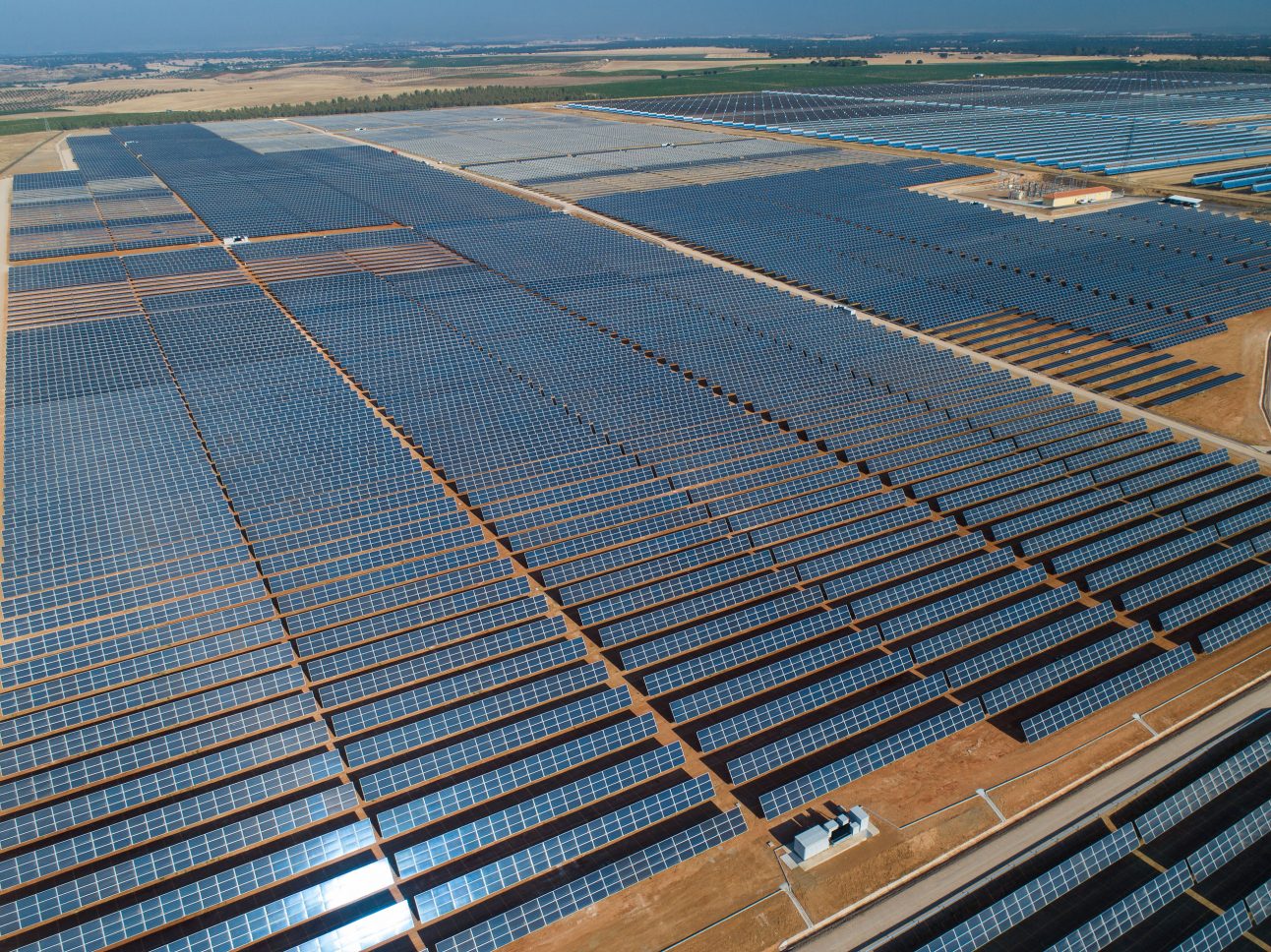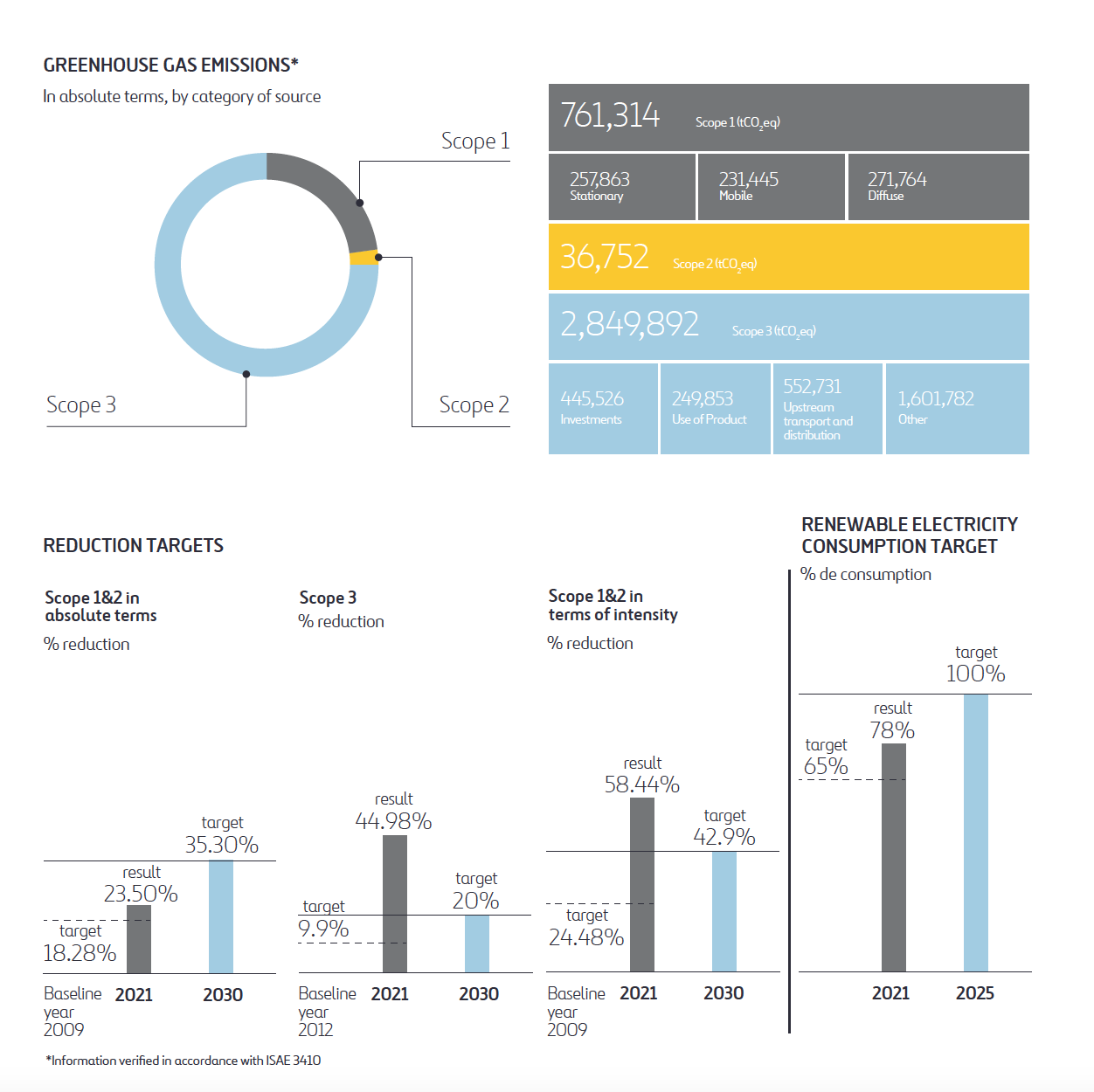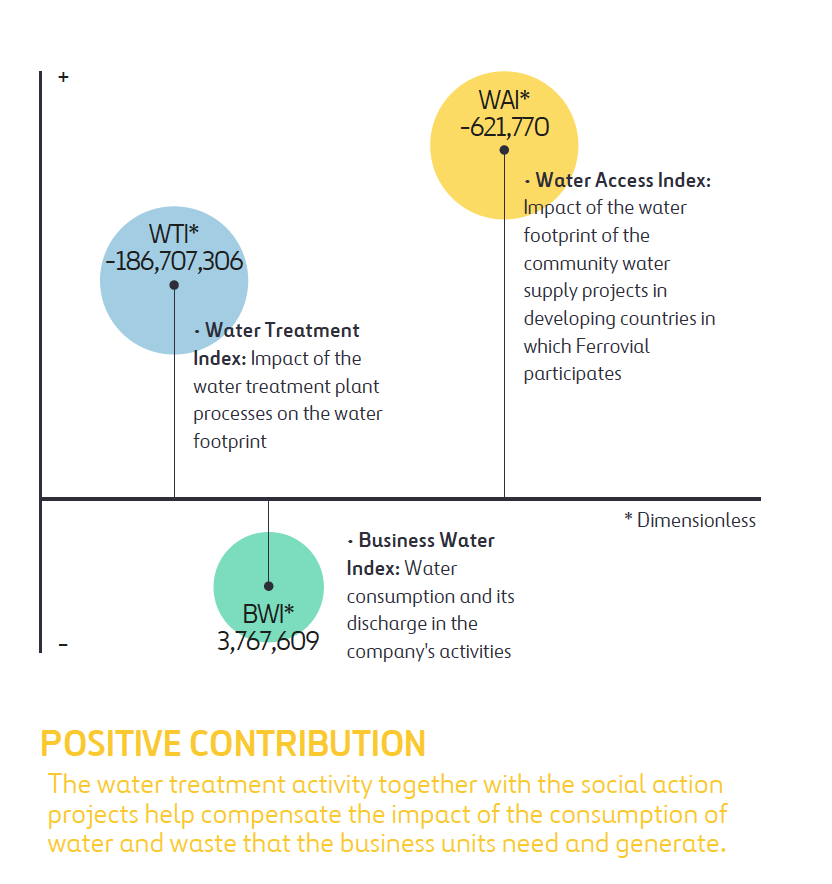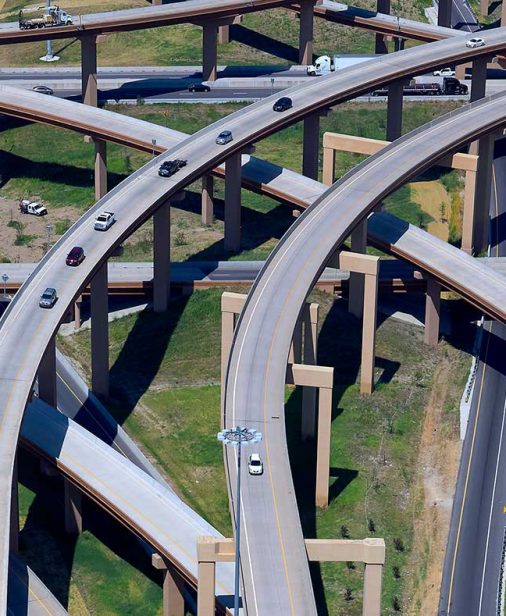-
1. Management Report 2021
- 1.1 In two minutes
- 1.2 Strategy and value creation
- 1.3 Ferrovial in 2021
- 1.4 Risks
- 1.5 Corporate Governance
- 1.6 Expected Business Performance in 2022
-
Appendix
- Alternative Performance Measures
- Sustainability Management
- Reporting Principles
- European Taxonomy
- Task Force on Climate Related Disclosures
- Scoreboard
- Contents of Non-Financial Information Statements
- SASB Indicators
- GRI Standard Indicators
- Appendix to GRI Standards Indicators
- Glosary of Terms
- Verification Report
-
2. Consolidated Financial Statements 2021
- Consolidated Financial Statements
- Audit Report
Environment
Decarbonizing the economy
Ferrovial’s Sustainability Strategy, aligned with the Horizon 24 Plan, covers the areas of climate change, biodiversity, circular economy and water. It also includes tangible and measurable objectives, with which it seeks to enhance its contribution to society.
REDUCTION OF GHG EMISSIONS
ELECTRICITY CONSUMED FROM RENEWABLE SOURCES
The Climate Strategy, integrated into the Sustainability Strategy, is the company’s commitment to contribute to the decarbonization of the economy, with an internal target to reach carbon neutrality by 2050, including the analysis and management of risks and opportunities related to climate change.
CLIMATE STRATEGY
Carbon Footprint
Since 2009, the Carbon Footprint has been calculated and reported for 100% of the activities under the operational control approach as an organizational boundary. The calculation method is mainly based on the GHG Protocol (WRI&WBCSD), while maintaining compliance with ISO 14064-1 standards.
Ferrovial has set ambitious reduction targets endorsed by the Science Based Target Initiative (SBTi) for the 2030 horizon in scopes 1, 2 and 3.
In addition, the company has set a goal of climate neutrality by 2050, through emission reductions and offsetting. The company has set a target of 100% renewable electricity consumption by 2025. To achieve this goal, it has focused on the electrification of its fleet, the implementation of energy efficiency measures in its processes and the construction and operation of a 50MW photovoltaic plant that will supply energy to its activities in Spain and Portugal.
During 2021, Ferrovial collaborated with the SBTi initiative in different phases of the Net-Zero Standard definition project and the development of the tool for calculating emissions reduction targets, which has enabled the company to further explore the different decarbonization pathways through the revision of the standard and the use of new tools.
In addition, Ferrovial is one of the first Ibex 35 companies to present and approve its Greenhouse Gas Emissions Reduction Plan for the 2030 and 2050 horizons at the General Shareholders’ Meeting.
Risks and opportunities related to climate change
Ferrovial follows the recommendations of the TCFD in its Integrated Annual Report. The company periodically performs an analysis and quantification of the risks and opportunities related to climate change in all its businesses and geographies.
The methodology considers transitional scenarios focused on the degree of implementation of climate change policies presented by the International Energy Agency (IEA) in its World Energy Outlook report, as well as physical scenarios that include various greenhouse gas emissions concentration scenarios and their physical impacts on the climate analyzed by experts from the Intergovernmental Panel on Climate Change (IPCC).
The study concludes that the short, medium and long-term risks are:
- Transition risks are related to the increase in operational costs due to the increase in raw material prices, establishment of carbon fee mechanisms or substitution of existing products and services with lower emissions. Aspects such as new regulations of existing products and services, water use restrictions, increased stakeholder concerns or changes in customer and consumer behavior are considered. The probability of occurrence of transitional risks and their financial impact is higher in the more sustainable scenario and lower in the business as usual scenario.
- Physical risks refer mainly to possible physical damage to infrastructure, decrease in productivity in extreme weather conditions or delay in delivery of products and services. The evolution of physical risks is the reverse of transitional risks, with a higher probability of occurrence in the high-emissions scenario and a lower probability of occurrence when moving towards the low-emissions scenario.
Ferrovial has the appropriate measures in place to mitigate, reduce and manage the risks related to climate change identified. These risks are incorporated into the corporate Ferrovial Risk Management (FRM) system and are reviewed on a biannual basis.
Shadow Carbon Pricing
Ferrovial applies a methodology to quantify the climate risk of its most relevant investments in the Shadow Carbon Pricing model to redirect its activity to more decarbonized business models. This tool considers variable prices per ton of carbon for different time horizons, geographies and projects types, thus quantifying the potential economic risk inherent in the projects.
BIODIVERSITY
Ferrovial incorporates the criteria of the mitigation hierarchy into its environmental management. The organizational and operational procedures that govern its contracts, as well as its environmental monitoring processes, are based on avoiding and minimizing the negative impact on the environment.
In order to ensure responsible management of biodiversity, the company has developed a methodology and an internal tool for calculating the natural capital debt called INCA, based on the automation of the calculation of the impact on biodiversity and ecosystem services.
Externally, it promotes biodiversity conservation through the natural capital task force coordinated by the Spanish Green Growth Group. In 2021, the TIFIES plan was launched, aimed at strengthening public-private collaboration to fight more effectively against illegal logging and wildlife trafficking, and reverse the progressive loss of biodiversity and natural ecosystems.
CIRCULAR ECONOMY
Ferrovial is consolidating the incorporation of circular economy principles in its processes, products and services. As a sign of its commitment and focus on circularity, in 2021 the development of the Circular Economy Plan has begun, structured in the following areas:
- Energy. Working on improving energy efficiency, the generation of renewable electricity for self-consumption and the purchase of electricity from renewable sources.
- Waste. Prioritizing the valorization of waste as a resource.
- Water. Increasing efficiency in water consumption and promoting its reuse and recycling throughout the activities.
- Materials. Focusing on the incorporation of recycled materials in construction processes.
The Construction activity also promotes the circular economy, reducing wherever possible the waste generated and optimizing the resources used in all sites and work centers, with annual targets of 80% reuse of soil, as well as 70% reuse of Construction and Demolition Waste (CDW).
In addition, sustainability criteria are applied in building construction, including eco-design measures and ensuring efficient management throughout the building’s life cycle. Newly constructed buildings incorporate environmental improvements with considerably lower energy consumption than conventional buildings.
Cadagua, the division specialized in water management, prioritizes waste minimization and recovery as part of its management while promoting the circular economy throughout its activities. As one of the circular economy measures, it is strongly committed to the recovery of hydrothermal carbonation. On the other hand, in innovation, new technologies are being explored that can reduce the volume of sewage sludge, as is the case of hydrothermal carbonation of sewage sludge. Another strategic line is energy efficiency and the reduction of electricity consumption from the grid due to the generation of renewable energy in the production centers.
WATER FOOTPRINT
The Water Policy recognizes water as a limited and irreplaceable natural resource and access to it as a fundamental human right, directly related to global change and a necessary element within the circular economy.
To quantify the impact on water resources caused by the company’s activities, a methodology has been developed for calculating the water footprint, considering aspects such as the source of the water, the country’s water stress and the quality of the water and discharges, considering the balance of the ecosystems in which it is located. In terms of management, the strategy considers the availability, quality and balance of ecosystems, with the aim of optimizing the use of water resources.
This corporate vision is evident in Cadagua’s business, where ensuring water supply and sanitation, protecting the environment and combating pollution are its main ambitions. Proper management is a tool in the fight against climate change, prevention of health problems, as well as a sign of commitment to society. Cadagua helps to meet these challenges with the highest quality and respect for the environment. This business line offers the opportunity to be one of the main players in key processes to meet the challenge of water supply, especially in areas with water shortages. On the innovation side, the company is evaluating the most appropriate treatments to eliminate contaminants of emerging concern, as well as antibiotic-resistant bacteria.
Ferrovial has set a target to reduce BWI by 20% by 2030 and offset BWI by 30 times annually (WTI+WAI > 30BWI).
Tool for the management of risks associated with climate change
As part of the climate change adaptation strategy, Ferrovial is working with a team of experts from the University of Cantabria led by a member of the IPCC to develop an internal tool to identify, evaluate and quantify physical risks and establish specific adaptation measures to reduce and mitigate them in Ferrovial’s activities. For this analysis, the RCP climate scenarios published in the IPCC report will be considered. This instrument will help the company to standardize the process, improve risk management and be more resilient to climate change by including these measures in the design phase of projects. Through this system, the company will respond to the European Union’s Taxonomy Regulation.
Reforestation works, emission absorption and offsetting projects
This was thanks to the Compensa project, in which forest restoration work is carried out in burned or agricultural areas to absorb and offset emissions. This initiative carried out in Torremocha de Jarama, in Madrid, seeks to recover the vegetation of an agricultural area lacking trees, converting it into a CO2 absorption forest. With its development, 7.7 hectares will be reforested in three years (4.8 in 2019, 1.8 in 2020 and 1.1 in 2021). A total of 4,000 trees have been planted, which over the next 50 years will absorb around 2,000 tons of CO2.

Solar photovoltaic power plant of “Los Limonetes” Badajoz, Spain.


